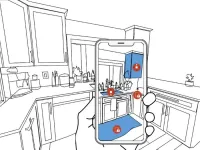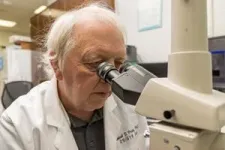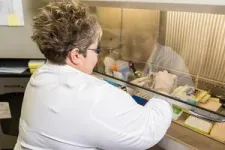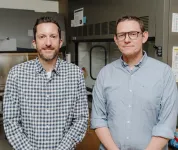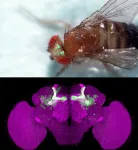(Press-News.org) Big Tech’s race into augmented reality (AR) grows more competitive by the day. This month, Meta released the latest iteration of its headset, the Quest 3. Early next year, Apple plans to drop its first headset, the Vision Pro. The announcements for each platform emphasize games and entertainment that merge the virtual and physical worlds: a digital board game imposed on a coffee table, a movie screen projected above airplane seats.
Some researchers, though, are more curious about other uses for AR. The University of Washington’s Makeability Lab is applying these budding technologies to assist people with disabilities. This month, researchers from the lab will introduce multiple projects that deploy AR — through headsets and phone apps — to make the world more accessible.
Researchers from the lab will first present RASSAR, an app that can scan homes to highlight accessibility and safety issues, on Oct. 23 at the ASSETS ‘23 conference in New York.
Shortly after, on Oct. 30, other teams in the lab will present early research at the UIST ‘23 conference in San Francisco. One app lets the headsets better understand natural language and the other aims to make tennis and other ball sports accessible for low-vision users.
UW News spoke with the three studies’ lead authors, Xia Su and Jae (Jaewook) Lee, both UW doctoral students in the Paul G. Allen School of Computer Science & Engineering, about their work and the future of AR for accessibility.
What is AR and how is it typically used right now?
Jae Lee: I think one commonly accepted answer is that you use a wearable headset or a phone to superimpose virtual objects in a physical environment. A lot of people probably know AR from “Pokémon Go,” where you're superimposing these Pokémon into the physical world. Now Apple and Meta are introducing “mixed reality” or passthrough AR, which further blends the physical and virtual worlds through cameras.
Xia Su: Something I have also been observing lately is people are trying to expand the definition beyond goggles and phone screens. There could be AR audio, which is manipulating your hearing, or devices trying to manipulate your smell or touch.
A lot of people associate AR with virtual reality, and it gets wrapped up in discussion of the metaverse and gaming. How is it being applied for accessibility?
JL: AR as a concept has been around for several decades. But in Jon Froehlich’s lab, we’re combining AR with accessibility research. A headset or a phone can be capable of knowing how many people are in front of us, for example. For people who are blind or low vision, that information could be critical to how they perceive the world.
XS: There are really two different routes for AR accessibility research. The more prevalent one is trying to make AR devices more accessible to people. The other, less common approach is asking: How can we use AR or VR as tools to improve the accessibility of the real world? That’s what we're focused on.
JL: As AR glasses become less bulky and cheaper, and as AI and computer vision advance, this research will become increasingly important. But widespread AR, even for accessibility, brings up a lot of questions. How do you deal with bystander privacy? We, as a society, understand that vision technology can be beneficial to blind and low-vision people. But we also might not want to include facial recognition technology in apps for privacy reasons, even if that helps someone recognize their friends.
Let’s talk about the papers you have coming out. First, can you explain your app RASSAR?
XS: It's an app that people can use to scan their indoor spaces and help them detect possible accessibility safety issues in homes. It’s possible because some iPhones now have lidar (light detection and ranging) scanners that tell the depth of a space, so we can reconstruct the space in 3D. We combined this with computer vision models to highlight ways to improve safety and accessibility. To use it, someone — perhaps a parent who’s childproofing a home, or a caregiver — scans a room with their smartphone and RASSAR spots accessibility problems. For example, if a desk is too high, a red button will pop up on the desk. If the user clicks the button, there will be more information about why that desk’s height is an accessibility issue and possible fixes.
JL: Ten years ago, you would have needed to go through 60 pages of PDFs to fully check a house for accessibility. We boiled that information down into an app.
And this is something that anyone will be able to download to their phones and use?
XS: That’s the eventual goal. We already have a demo. This version relies on lidar, which is only on certain iPhone models right now. But if you have such a device, it’s very straightforward.
JL: This is an example of these advancements in hardware and software that let us create apps quickly. Apple announced RoomPlan, which creates a 3D floor plan of a room, when they added the lidar sensor. We’re using that in RASSAR to understand the general layout. Being able to build on that lets us come up with a prototype very quickly.
So RASSAR is nearly deployable now. The other areas of research you’re presenting are earlier in their development. Can you tell me about GazePointAR?
JL: It’s an app deployed on an AR headset to enable people to speak more naturally with voice assistants like Siri or Alexa. There are all these pronouns we use when we speak that are difficult for computers to understand without visual context. I can ask “Where'd you buy it from?” But what is “it”? A voice assistant has no idea what I’m talking about. With GazePointAR, the goggles are looking at the environment around the user and the app is tracking the user’s gaze and hand movements. The model then tries to make sense of all these inputs — the word, the hand movements, the user’s gaze. Then, using a large language model, GPT, it attempts to answer the question.
How does it sense what the motions are?
JL: We’re using a headset called HoloLens 2 developed by Microsoft. It has a gaze tracker that’s watching your eyes and trying to guess what you’re looking at. It has hand tracking capability as well. In a paper that we submitted building on this, we noticed that we have a lot of problems with this. For example, people don't just use one pronoun at a time — we use multiple. We’ll say, “What's more expensive, this or this?” To answer that, we need information over time. But, again, you can run into privacy issues if you want to track someone's gaze or someone's visual field of view over time: What information are you storing and where is it being stored? As technology improves, we certainly need to watch out for these privacy concerns, especially in computer vision.
This is difficult even for humans, right? I can ask, “Can you explain that?” while pointing at several equations on a whiteboard and you won’t know which I’m referring to. What applications do you see for this?
JL: Being able to use natural language would be major. But if you expand this to accessibility, there’s the potential for a blind or low-vision person to use this to describe what’s around them. The question “Is anything dangerous in front of me?” is also ambiguous for a voice assistant. But with GazePointAR, ideally, the system could say, “There are possibly dangerous objects, such as knives and scissors.” Or low-vision people might make out a shape, point at it, then ask the system what “it” is more specifically.
And finally you’re working on a system called ARTennis. What is it and what prompted this research?
JL: This is going even more into the future than GazePointAR. ARTennis is a prototype that uses an AR headset to make tennis balls more salient for low vision players. The ball in play is marked by a red dot and has a crosshair of green arrows around it. Professor Jon Froehlich has a family member that wants to play sports with his children but doesn't have the residual vision necessary to do so. We thought if it works for tennis, it's going to work for a lot of other sports, since tennis has a small ball that shrinks as it gets further away. If we can track a tennis ball in real time, we can do the same with a bigger, slower basketball.
One of the co-authors on the paper is low vision himself, and he plays a lot of squash, and he wanted to try this application and give us feedback. We did a lot of brainstorming sessions with him, and he tested the system. The red dot and green crosshairs is the design that he came up with, to improve the sense of depth perception.
What’s keeping this from being something people can use right away?
JL: Well, like GazePointAR, it’s relying on a HoloLens 2 headset that’s $3,500. So that’s a different accessibility issue. It’s also running at roughly 25 frames per second and for humans to perceive in real time it needs to be about 30 frames per second. Sometimes we can’t capture the speed of the tennis ball. We're going to expand the paper and include basketball to see if there are different designs people prefer for different sports. The technology will certainly get faster. So our question is: What will the best design be for the people using it?
For more information, contact Jon Froehlich at jonf@cs.washington.edu, Lee at jaewook4@cs.washington.edu and Su at xiasu@cs.washington.edu.
END
Q&A: Researchers aim to improve accessibility with augmented reality
2023-10-17
ELSE PRESS RELEASES FROM THIS DATE:
SEC Insider Trading Rule Has Loopholes
2023-10-17
AUSTIN, Texas -- A rule to limit trading based on nonpublic stock information has limited effectiveness, according to a recent study by Texas McCombs Finance Professor Robert Parrino.
Issued in 2000 by the Securities & Exchange Commission, Rule 10b5–1 requires corporate insiders to schedule the purchase or sale of a predetermined number of shares through a third-party broker up to two years in advance. Because the trades under these “plan” sales are scheduled in advance of their execution, insiders are presumed less likely to be acting on inside information.
But ...
Smart brain-wave cap recognizes stroke before the patient reaches the hospital
2023-10-17
A special brain-wave cap can diagnose stroke in the ambulance, allowing the patient to receive appropriate treatment faster. Jonathan Coutinho, neurologist at Amsterdam UMC, is one of the inventors the swimming cap: "Our research shows that the brain-wave cap can recognize patients with large ischemic stroke with great accuracy. This is very good news, because the cap can ultimately save lives by routing these patients directly to the right hospital." The research is published today in Neurology.
Every year, millions of people worldwide suffer an ischemic stroke, the most common type of stroke. An ischemic stroke occurs ...
Researchers receive $423,500 for study to improve outcomes from fungal infections
2023-10-17
Aspergillus fumigatus is the major airborne fungus present indoors and outdoors that causes various diseases, the severity of which are dependent on an individual’s immune status.
Researchers in the College of Pharmacy at the University of Tennessee Health Science Center have received a $423,500 grant from the National Institute of Allergy and Infectious Diseases (NIAID) of the National Institutes of Health for research aimed at reducing disease and mortality rates associated with Aspergillus infections ...
Air pollution and breast cancer risk - a link that calls for political action
2023-10-17
Lugano, Switzerland, 17 October 2023 – Women living and working in places with higher levels of fine particle air pollution are more likely to get breast cancer than those living and working in less polluted areas. Results of the first study to take account of the effects of both residential and workplace exposure to air pollution on breast cancer risk are presented at the ESMO Congress 2023 in Madrid, Spain (1).
“Our data showed a statistically significant association between long term exposure to fine particle air pollution, at home and at work, and risk of breast cancer. This contrasts with previous research which looked only at fine particle exposure ...
Thermosensation is critical for the survival of animals, but the mechanisms by which this is modulated by nutritional status remain unclear
2023-10-17
Thermosensation is critical for the survival of animals, but the mechanisms by which this is modulated by nutritional status remain unclear; here, behavioral and live brain imaging studies reveal why food-sated fruit flies prefer to stay at relatively higher temperatures compared to hungry flies.
#####
In your coverage, please use this URL to provide access to the freely available paper in PLOS Biology: http://journals.plos.org/plosbiology/article?id=10.1371/journal.pbio.3002332
Article Title: Independent insulin signaling modulators govern hot avoidance ...
Multi-drug resistant strain of E.coli battles bacteria in healthy gut
2023-10-17
Different strains of E.coli can outcompete one another to take over the gut, a new study reveals.
Publishing their findings today in PLOS Biology, scientists reveal that a particular strain, known as MDR ST131, can readily colonise new hosts, even if those hosts are already have E.coli in their healthy gut.
The international team, led by experts at the University of Birmingham, used a mouse model to help understand why strains of E.coli that live in a healthy gut are rapidly overtaken of when challenged with a multi-drug resistant strain.
Lead author Professor Alan McNally, from ...
Sleep and stress give clues to understanding epileptic seizures - study
2023-10-17
Sleeping patterns and stress hormones could be the key to understanding how and when people with epilepsy are likely to experience seizures, a new study reveals.
Researchers used mathematical modelling to understand the impact of different physiological processes, such as sleep and changes in concentration of the stress-hormone cortisol, on key signatures of epilepsy – known as epileptiform discharges (ED).
Epilepsy is a serious neurological disorder characterised by a tendency to have recurrent, spontaneous seizures. Classically, seizures were assumed to occur at random, until the discovery of ED activity with timescales that vary from hours and days through to months.
The scientists ...
The Dompé Foundation launches 16 scholarships for neuroscience and neurobiology students in the US
2023-10-17
The Dompé Foundation is offering 16 scholarships to support neuroscience and neurobiology students enrolled at US universities for the academic year 2023/2024. This funding opportunity, which honors the legacy of the only female Italian Nobel laureate in Medicine, is intended for promising candidates from any nationality that have already been admitted to a Master’s, PhD or post-doc program. With a total budget of up to about 1 million USD, the Foundation has doubled from the previous two years its funding for the US project, ...
NASA September 2023 temperature data shows continued record warming
2023-10-17
Continuing the temperature trend from this summer, September 2023 was the hottest September on record, according to scientists at NASA’s Goddard Institute for Space Studies (GISS). The month also set the record for the highest temperature anomaly – the largest difference from the long-term average.
This visualization shows global temperature anomalies along with the underlying seasonal cycle. Temperatures advance from January through December left to right, rising during warmer months and falling during cooler months. The color of each line represents the year, with colder purples for the 1960s and warmer oranges and yellows for more recent ...
Researchers test seafloor fiber optic cable as an earthquake early warning system
2023-10-17
One of the biggest challenges for earthquake early warning systems (EEW) is the lack of seismic stations located offshore of heavily populated coastlines, where some of the world’s most seismically active regions are located. In a new study published in The Seismic Record, researchers show how unused telecommunications fiber optic cable can be transformed for offshore EEW.
Jiuxun Yin, a Caltech researcher now at SLB, and colleagues used 50 kilometers of a submarine telecom cable running between the United States and Chile, sampling ...
